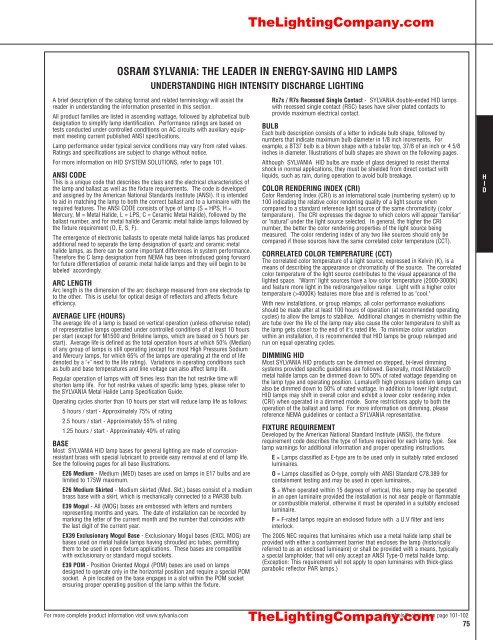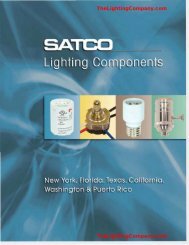Lamp and Ballast Catalog - The Lighting Company
Lamp and Ballast Catalog - The Lighting Company
Lamp and Ballast Catalog - The Lighting Company
- No tags were found...
Create successful ePaper yourself
Turn your PDF publications into a flip-book with our unique Google optimized e-Paper software.
<strong>The</strong><strong>Lighting</strong><strong>Company</strong>.com<br />
OSRAM SYLVANIA: THE LEADER IN ENERGY-SAVING HID LAMPS<br />
UNDERSTANDING HIGH INTENSITY DISCHARGE LIGHTING<br />
A brief description of the catalog format <strong>and</strong> related terminology will assist the<br />
reader in underst<strong>and</strong>ing the information presented in this section.<br />
All product families are listed in ascending wattage, followed by alphabetical bulb<br />
designation to simplify lamp identification. Performance ratings are based on<br />
tests conducted under controlled conditions on AC circuits with auxiliary equipment<br />
meeting current published ANSI specifications.<br />
<strong>Lamp</strong> performance under typical service conditions may vary from rated values.<br />
Ratings <strong>and</strong> specifications are subject to change without notice.<br />
For more information on HID SYSTEM SOLUTIONS, refer to page 101.<br />
ANSI CODE<br />
This is a unique code that describes the class <strong>and</strong> the electrical characteristics of<br />
the lamp <strong>and</strong> ballast as well as the fixture requirements. <strong>The</strong> code is developed<br />
<strong>and</strong> assigned by the American National St<strong>and</strong>ards Institute (ANSI). It is intended<br />
to aid in matching the lamp to both the correct ballast <strong>and</strong> to a luminaire with the<br />
required features. <strong>The</strong> ANSI CODE consists of type of lamp (S = HPS, H =<br />
Mercury, M = Metal Halide, L = LPS, C = Ceramic Metal Halide), followed by the<br />
ballast number, <strong>and</strong> for metal halide <strong>and</strong> Ceramic metal halide lamps followed by<br />
the fixture requirement (O, E, S, F).<br />
<strong>The</strong> emergence of electronic ballasts to operate metal halide lamps has produced<br />
additional need to separate the lamp designation of quartz <strong>and</strong> ceramic metal<br />
halide lamps, as there can be some important differences in system performance.<br />
<strong>The</strong>refore the C lamp designation from NEMA has been introduced going forward<br />
for future differentiation of ceramic metal halide lamps <strong>and</strong> they will begin to be<br />
labeled accordingly.<br />
ARC LENGTH<br />
Arc length is the dimension of the arc discharge measured from one electrode tip<br />
to the other. This is useful for optical design of reflectors <strong>and</strong> affects fixture<br />
efficiency.<br />
AVERAGE LIFE (HOURS)<br />
<strong>The</strong> average life of a lamp is based on vertical operation (unless otherwise noted)<br />
of representative lamps operated under controlled conditions of at least 10 hours<br />
per start (except for M1500 <strong>and</strong> Briteline lamps, which are based on 5 hours per<br />
start). Average life is defined as the total operation hours at which 50% (Median)<br />
of any group of lamps is still operating (except for most High Pressures Sodium<br />
<strong>and</strong> Mercury lamps, for which 65% of the lamps are operating at the end of life<br />
denoted by a "+" next to the life rating). Variations in operating conditions such<br />
as bulb <strong>and</strong> base temperatures <strong>and</strong> line voltage can also affect lamp life.<br />
Regular operation of lamps with off times less than the hot restrike time will<br />
shorten lamp life. For hot restrike values of specific lamp types, please refer to<br />
the SYLVANIA Metal Halide <strong>Lamp</strong> Specification Guide.<br />
Operating cycles shorter than 10 hours per start will reduce lamp life as follows:<br />
5 hours / start - Approximately 75% of rating<br />
2.5 hours / start - Approximately 55% of rating<br />
1.25 hours / start - Approximately 40% of rating<br />
BASE<br />
Most SYLVANIA HID lamp bases for general lighting are made of corrosionresistant<br />
brass with special lubricant to provide easy removal at end of lamp life.<br />
See the following pages for all base illustrations.<br />
E26 Medium - Medium (MED) bases are used on lamps in E17 bulbs <strong>and</strong> are<br />
limited to 175W maximum.<br />
E26 Medium Skirted - Medium skirted (Med. Skt.) bases consist of a medium<br />
brass base with a skirt, which is mechanically connected to a PAR38 bulb.<br />
E39 Mogul - All (MOG) bases are embossed with letters <strong>and</strong> numbers<br />
representing months <strong>and</strong> years. <strong>The</strong> date of installation can be recorded by<br />
marking the letter of the current month <strong>and</strong> the number that coincides with<br />
the last digit of the current year.<br />
EX39 Exclusionary Mogul Base - Exclusionary Mogul bases (EXCL MOG) are<br />
bases used on metal halide lamps having shrouded arc tubes, permitting<br />
them to be used in open fixture applications. <strong>The</strong>se bases are compatible<br />
with exclusionary or st<strong>and</strong>ard mogul sockets.<br />
E39 POM - Position Oriented Mogul (POM) bases are used on lamps<br />
designed to operate only in the horizontal position <strong>and</strong> require a special POM<br />
socket. A pin located on the base engages in a slot within the POM socket<br />
ensuring proper operating position of the lamp within the fixture.<br />
Rx7s / R7s Recessed Single Contact - SYLVANIA double-ended HID lamps<br />
with recessed single contact (RSC) bases have silver plated contacts to<br />
provide maximum electrical contact.<br />
BULB<br />
Each bulb description consists of a letter to indicate bulb shape, followed by<br />
numbers that indicate maximum bulb diameter in 1/8 inch increments. For<br />
example, a BT37 bulb is a blown shape with a tubular top, 37/8 of an inch or 4 5/8<br />
inches in diameter. Illustrations of bulb shapes are shown on the following pages.<br />
Although SYLVANIA HID bulbs are made of glass designed to resist thermal<br />
shock in normal applications, they must be shielded from direct contact with<br />
liquids, such as rain, during operation to avoid bulb breakage.<br />
COLOR RENDERING INDEX (CRI)<br />
Color Rendering Index (CRI) is an international scale (numbering system) up to<br />
100 indicating the relative color rendering quality of a light source when<br />
compared to a st<strong>and</strong>ard reference light source of the same chromaticity (color<br />
temperature). <strong>The</strong> CRI expresses the degree to which colors will appear "familiar"<br />
or "natural" under the light source selected. In general, the higher the CRI<br />
number, the better the color rendering properties of the light source being<br />
measured. <strong>The</strong> color rendering index of any two like sources should only be<br />
compared if those sources have the same correlated color temperature (CCT).<br />
CORRELATED COLOR TEMPERATURE (CCT)<br />
<strong>The</strong> correlated color temperature of a light source, expressed in Kelvin (K), is a<br />
means of describing the appearance or chromaticity of the source. <strong>The</strong> correlated<br />
color temperature of the light source contributes to the visual appearance of the<br />
lighted space. "Warm" light sources have a low color temperature (2000-3000K)<br />
<strong>and</strong> feature more light in the red/orange/yellow range. Light with a higher color<br />
temperature (>4000K) features more blue <strong>and</strong> is referred to as "cool."<br />
With new installations, or group relamps, all color performance evaluations<br />
should be made after at least 100 hours of operation (at recommended operating<br />
cycles) to allow the lamps to stabilize. Additional changes in chemistry within the<br />
arc tube over the life of the lamp may also cause the color temperature to shift as<br />
the lamp gets closer to the end of it's rated life. To minimize color variation<br />
within an installation, it is recommended that HID lamps be group relamped <strong>and</strong><br />
run on equal operating cycles.<br />
DIMMING HID<br />
Most SYLVANIA HID products can be dimmed on stepped, bi-level dimming<br />
systems provided specific guidelines are followed. Generally, most Metalarc®<br />
metal halide lamps can be dimmed down to 50% of rated wattage depending on<br />
the lamp type <strong>and</strong> operating position. Lumalux® high pressure sodium lamps can<br />
also be dimmed down to 50% of rated wattage. In addition to lower light output,<br />
HID lamps may shift in overall color <strong>and</strong> exhibit a lower color rendering index<br />
(CRI) when operated in a dimmed mode. Some restrictions apply to both the<br />
operation of the ballast <strong>and</strong> lamp. For more information on dimming, please<br />
reference NEMA guidelines or contact a SYLVANIA representative.<br />
FIXTURE REQUIREMENT<br />
Developed by the American National St<strong>and</strong>ard Institute (ANSI), the fixture<br />
requirement code describes the type of fixture required for each lamp type. See<br />
lamp warnings for additional information <strong>and</strong> proper operating instructions.<br />
E = <strong>Lamp</strong>s classified as E-type are to be used only in suitably rated enclosed<br />
luminaires.<br />
O = <strong>Lamp</strong>s classified as O-type, comply with ANSI St<strong>and</strong>ard C78.389 for<br />
containment testing <strong>and</strong> may be used in open luminaires.<br />
S = When operated within 15 degrees of vertical, this lamp may be operated<br />
in an open luminaire provided the installation is not near people or flammable<br />
or combustible material, otherwise it must be operated in a suitably enclosed<br />
luminaire.<br />
F = F-rated lamps require an enclosed fixture with a U.V filter <strong>and</strong> lens<br />
interlock.<br />
<strong>The</strong> 2005 NEC requires that luminaires which use a metal halide lamp shall be<br />
provided with either a containment barrier that encloses the lamp (historically<br />
referred to as an enclosed luminaire) or shall be provided with a means, typically<br />
a special lampholder, that will only accept an ANSI Type-O metal halide lamp.<br />
(Exception: This requirement will not apply to open luminaires with thick-glass<br />
parabolic reflector PAR lamps.)<br />
H<br />
I<br />
D<br />
<strong>The</strong><strong>Lighting</strong><strong>Company</strong>.com<br />
For more complete product information visit www.sylvania.com Symbols/Footnotes on page 101-102<br />
75




